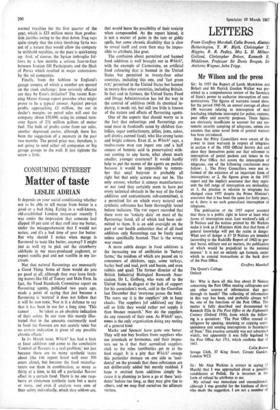Matter of taste
CONSUMING INTEREST LESLIE ADRIAN
It depends on your social conditioning whether not to be able to tell marge from butter is a good or a bad thing. Eating in a well-known, old-established London restaurant recently I was under the impression that someone had slipped 10 per cent of that stuff into my butter, under the misapprehension that I would not notice, and it's a bad time of year for butter. But why should I notice when marge is flavoured to taste like butter, anyway? I might just as well try to pick out the strawberry aldehyde in my mass-produced yoghourt, or expect vanilla pod and not vanillin in my ice- cream.
Not that natural flavourings are necessarily a Good Thing. Some of them would do you no good at all, although they may have fetch- ing names like Oil of Tansey and Male Fern. In fact, the Food Standards Committee report on flavouring agents, published two years ago, made a point of saying that just because a flavouring is 'natural' it does not follow that it will be non-toxic. Nor is it a defence to say that it has been in use for a long time. 'This cannot . . be taken as an absolute indication of their safety. In our view this merely illus- trated that in the amounts customarily used in food the flavours are not acutely toxic but no certain indication is given of any possible chronic effects.'
In its March issue, Which? has had a look at food additives and come to the conclusion 'Control of flavours is a real problem,' not just because there are so many synthetic tastes about (the FSC report listed well over 500 esters alone), but because the food manufac- turers use them in combination, as many as thirty at a time, to hit off a particular flavour effect in a certain food. There is no one rasp- berry or cinnamon synthetic taste but a score or more, and even if analysts were sure of their safety individually, which they seldom are,
that would leave the possibility of their toxicity when compounded. As the report hinted, it is not a matter of pains in the turn or giddy spells, but some chronic disability that is slow to reveal itself and even then may be impos- sible to attribute, like gout.
The confusion about permitted and banned food additives is well brought out in Which?, with the example of Carmoisine, an artificial food colouring that is banned in the United States but permitted in twenty-four other countries, including this one, and 'fast green ['CP,' permitted in the United States but banned in twenty-five other countries, including Britain. In fact and in fairness, the United States Food and Drugs Administration has led the way in the control of additives (with its chemical in- dustry, it needs to), but still too little is known of the nature and effects of flavouring agents.
One of the aspects that should worry us is the fact that colourings and flavourings are used most in foodstuffs eaten by children (ice- lollies, sugar confectionery, jellies, jams, cakes, soft drinks, canned food), who like strong tastes and bright colours. Even if, as Which? says, a twelve-stone man can ingest one and a half ounces of benzoic acid (a preservative) with- out coming to any harm, what about much smaller, younger creatures? It would hardly help to put the names of the agents on packets because it would be impossible to remem- ber that amyl butyrate is probably all right but that airily acetate may not be. The only answer, whether it annoys manufacturers or not (and they certainly seem to have put every technical obstacle in the way of the food additives and contaminants sub-committee), is a permitted list on which every natural and synthetic substance has been thoroughly tested before inclusion. The FSC report recorded that there were no 'toxicity data' on most of the flavourings listed, all of which had been sub- mitted to them. It is an odd oversight on the part of our health authorities that of all food additives only flavourings can be freely used unless specifically banned. That is the wrong way round.
A more subtle danger in food additives is the increasing use of antibiotics in 'factory farms,' the residues of which are passed on to consumers of chickens, eggs, some turkeys, barley beef and veal, pork and bacon, and even rabbits and quail. The former director of the British Industrial Biological Research Asso- ciation, Dr L Golberg, who went off to the United States in disgust at the lack of support for his association's work, said in the Guardian last December that 'everyone passes the buck. The users say it is the suppliers' job to keep checks. The suppliers [of additives] say they sell so little they would rather not supply it than finance research.' Nor do the suppliers do any research of their own. As Which' says, BIBRA is the only organisation doing any testing of a general kind.
Marks and Spencer have gone one better. They will not buy broilers from suppliers who use arsenicals or hormones, and their inspec- tors see to it that their accredited suppliers stick to the rules (antibiotics get in at the feed stage). It is a pity that Which? sweeps this particular menace on one side as 'acci- dental' on the grounds that these substances are not deliberately added but merely residual. I hope it omitted farm additives simply be- cause it is planning to have a go at these 'acci- dents' before too long, as they may give rise to others, and we may find ourselves the ultimate victims.






























 Previous page
Previous page